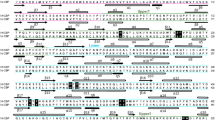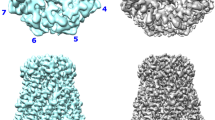Abstract
The refined 1.9-Å resolution structure of the periplasmic D-galac-tose-binding protein (GBP) reveals a calcium ion surrounded by seven ligands, all protein oxygen atoms. A nine-residue loop (amino-acid positions 134–142), which is preceded by a /β-turn and followed by a β-strand, provides five ligands from every second residue. The last two ligands are supplied by the carboxylate group of Glu 205. The entire GBP Ca2+-binding site adopts a conformation very similar to the site in the 'helix-loop-helix' or 'EF-hand' unit commonly found in intracellular calcium-binding proteins1, but without the two helices. Structural analyses have also uncovered the sugar-binding site some 30 Å from the calcium and a site for interacting with the membrane-bound trg chemotactic signal transducer ∼45 Å from the calcium. Our results show that a common tight calcium binding site of ancient origin can be tethered to different secondary structures. They also provide the first demonstration of a metal-binding site in a protein which is involved in bacterial active transport and chemotaxis.
This is a preview of subscription content, access via your institution
Access options
Subscribe to this journal
Receive 51 print issues and online access
$199.00 per year
only $3.90 per issue
Buy this article
- Purchase on Springer Link
- Instant access to full article PDF
Prices may be subject to local taxes which are calculated during checkout
Similar content being viewed by others
References
1. Kretsinger, R. H. & Nockolds, C. E. /. biol Chem. 248, 3313–3326 (1973). 2. Anraku, Y. /. biol. Chem. 242, 793–800 (1967). 3. Hazelbauer, G. L. & Adler, J. Nature new Biol. 230, 101–104 (1971). 4. Quiocho, F. A. & Vyas, N. K. Nature 310, 381–386 (1984). 5. Pflugrath, J. W. & Quiocho, F. A. Nature 314, 257–260 (1985). 6. Saper, M. A. & Quiocho, F. A../ biol. Chem. 258, 11057–11062 (1983). 7. Quiocho, F. A. et al in Crystallography in Molecular Biology NATO Series (eds Moras, D. et al.) 385–394 (Plenum, London, 1986). 8. Kubena, B. D., Luecke, H., Rosenberg, H. & Quiocho, F. A. J. biol. Chem. 261, 7995–7996 (1986). 9. Vyas, N. K., Vyas, M. N. & Quiocho, F. A. Proc. natn. Acad. Sci. U.S.A. 80,1792–1796 (1983). 10. Ames, G.–L. A. Rev. Biochem. 55, 397–425 (1986). 11. Koshland, D. E. A. Rev. Biochem. 50, 765–782 (1981). 12. Ordal, G. W. & Adler, J. J. Bact. 117, 517–526 (1974). 13. Scholle, A. et al. Molec. Gen. Genet, (in the press). 14. Kretsinger, R. H. CRC Crit. Rev. Biochem. 8, 119–174 (1980). 15. Herzberg, O. & James, M. N. G. Biochemistry 24, 5298–5302 (1985). 16. Stuart, D. I. et al. Nature 324, 84–87 (1986). 17. Mahoney, W. C., Hogg, R. W. & Hermodson, M. A. J, biol. Chem. 256, 4350–4356 (1981). 18. Coffee, C. J. & Bradshaw, R. A. /. biol. Chem. 248, 3305–3312 (1973). 19. Wilkinson, J. M. FEBS Lett. 70, 254–256 (1976). 20. Fullmer, C. S. & Wasserman, R. H. /. biol. Chem. 256, 5669–5674 (1981). 21. Watterson, D. M., Sharief, F. S. & Vanaman, T. C. J. biol. Chem. 255, 962–971 (1980). 22. Hendrickson, W. A. & Konnert, H. H. in Biomolecular Structure, Function, Conformation and Evolution Vol. I (ed. Srinivasan, R.) 43–57 (Pergamon, Oxford, 1980). 23. Pflugrath, J. W., Saper, M. A. & Quiocho, F. A. in Computational Crystallography (eds . Hall, S. R. & Ashida, T.) 404–407 (Clarendon, Oxford, 1984). 24. Bernstein, F. C. et al. J. molec. Biol. 112, 535–542 (1977).
Author information
Authors and Affiliations
Rights and permissions
About this article
Cite this article
Vyas, N., Vyas, M. & Quiocho, F. A novel calcium binding site in the galactose-binding protein of bacterial transport and chemotaxis. Nature 327, 635–638 (1987). https://doi.org/10.1038/327635a0
Received:
Accepted:
Issue Date:
DOI: https://doi.org/10.1038/327635a0
Comments
By submitting a comment you agree to abide by our Terms and Community Guidelines. If you find something abusive or that does not comply with our terms or guidelines please flag it as inappropriate.



